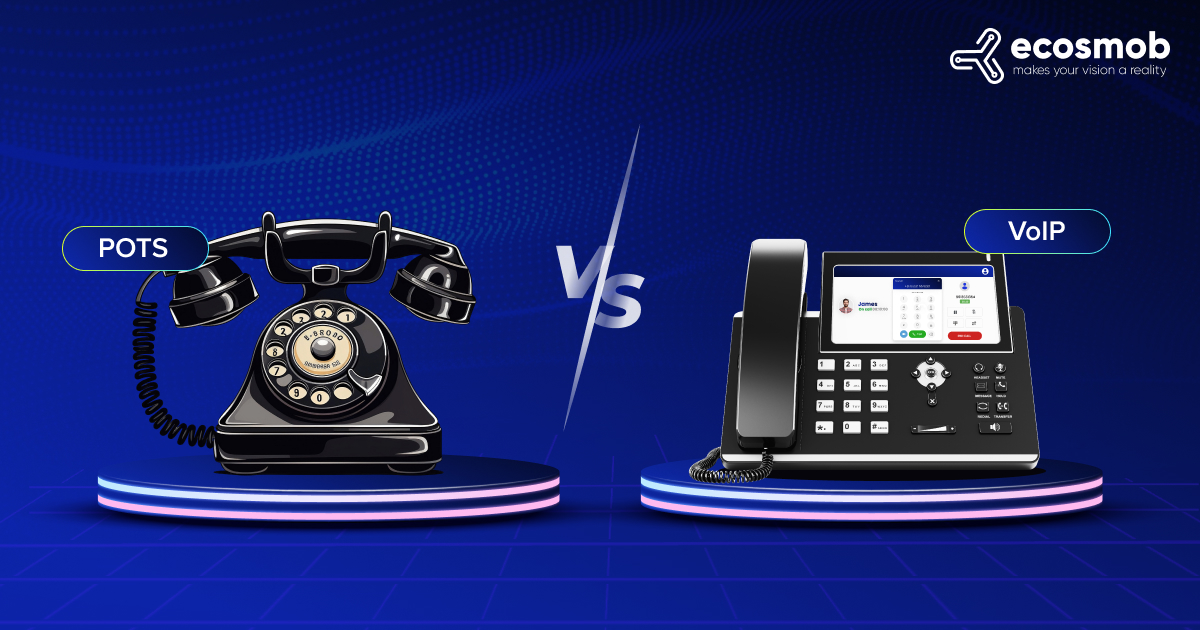In today’s fast-paced world, where businesses depend heavily on technology, VoIP (Voice over Internet Protocol) has emerged as a reliable communication solution. It enables companies to make calls over the Internet, which makes communication faster and more affordable than traditional phone systems. However, despite its many benefits, the quality of VoIP calls is often a concern for businesses. Poor VoIP call quality can cause frustration, decrease productivity, and negatively impact customer satisfaction. To help enterprises to ensure VoIP quality tests, Ecosmob Technologies presents six ways to amplify VoIP call quality.
However, we will explore the factors influencing voice quality in VoIP calls before diving in.
Let’s discuss it!
What Factors Affect VoIP Voice Quality?
Several factors can affect the voice quality of a VoIP (Voice over Internet Protocol) call. Some of the most significant characteristics are:
- Internet Bandwidth: The term “Internet Bandwidth” refers to the data transferred over a network within a specific time frame. Insufficient bandwidth can cause voice data to be dropped, resulting in poor voice quality during a VoIP call. Therefore, businesses must ensure sufficient internet bandwidth to support their VoIP systems.
- Latency: The time delay between both sending and receiving a signal is known as latency. In VoIP calls, latency refers to the delay between when a speaker speaks and when the listener hears the message. High latency can cause conversations to be disjointed and awkward, reducing the quality of the call.
- Network Jitter: Jitter is the variation in delay between data packets. In VoIP calls, jitter can cause voice data to be delivered out of order, leading to choppy and distorted audio.
- Codecs and Protocols: Codecs are software or hardware that encode and decode voice data into digital signals. VoIP relies heavily on codecs. These codecs compress audio signals before transferring them over an IP network, then decompress them before playing them back. Not all codecs have the same degree of performance or bandwidth and license needs. G.729, G.711, Speex, and several additional codecs are the most used in VoIP telephony.
Protocols like SIP and H.323 may also influence quality. Although H.323 continues to be used in some video conferencing systems, SIP has been popular generally in most VoIP implementations. SIP is normally better for troubleshooting, permitting better call quality consistency, and uses fewer resources.
- Network congestion: When too much data is transmitted through a network, congestion results in delays and dropped packets. Network congestion can adversely affect VoIP calls, leading to poor call quality.
To do VoIP quality tests, various VoIP quality testing tools are available that can simulate different network conditions and help identify and troubleshoot issues related to call quality.
Want to Make Sure Your VoIP Calls Sound Crystal-Clear?
How Can VoIP Call Quality Be Improved?
We’ve discussed and comprehended the aspects affecting VoIP call quality. Always look for ways to raise the quality of VoIP calls. Improving call quality can be difficult and expensive, but this should allow any company to operate normally. Several ways exist to enhance the quality of your VoIP (Voice over Internet Protocol) calls. Here are some suggestions:
Evaluate Your Network
You need to evaluate your network before improving your VoIP calls’ quality. Your network is the backbone of your VoIP system, and if it needs to be more vital to handle VoIP traffic, you will experience poor call quality. You can start by conducting a network assessment to identify any potential issues. A network assessment will help determine if your network has enough capacity to handle VoIP traffic and if your infrastructure optimizes for VoIP. It will also help you identify network issues impacting call quality, such as packet loss, latency, or jitter.
Optimize Your Network
Once you have evaluated your network, optimize it for VoIP traffic. It can involve upgrading your network infrastructure, such as routers, switches, and firewalls for VoIP traffic. You can also prioritize VoIP traffic over other types of traffic on your network by using Quality of Service settings. Quality of service settings allows you to assign priority levels for different kinds of traffic, ensuring that VoIP traffic receives the necessary bandwidth and resources to ensure high call quality.
Choose the Right VoIP Provider
Choosing the right VoIP provider is critical to ensuring high-quality VoIP calls. When selecting a VoIP provider, you should consider their call quality, uptime, and customer support. It would be best to seek a provider offering VoIP quality testing to ensure their system delivers high-quality calls. Some VoIP providers offer free trials or demos, which allow you to test their service before committing to a contract.
Use High-Quality Hardware
The quality of your VoIP calls impacts the hardware you use. You should invest in high-quality hardware, such as IP phones and headsets, designed to work with VoIP systems. Low-quality hardware can cause call clarity and volume issues, impacting call quality. Ensuring your hardware is configured correctly and optimized for VoIP traffic is also essential.
For more info, Read VoIP Quality Testing – All You Need to Know to Understand about VoIP Quality Testing.
Perform Regular VoIP Quality Testing
Regular VoIP quality testing is essential to ensuring high-quality VoIP calls. It involves measuring the performance of your VoIP system, including call quality, latency, packet loss, and jitter. Regular VoIP quality testing can identify any issues with your system before they impact call quality. It allows you to take corrective action to ensure high-quality VoIP calls.
Implement Call Quality Monitoring
Call quality monitoring is a proactive approach to ensuring high-quality VoIP calls. Call quality monitoring involves monitoring VoIP calls in real-time to identify any issues that could impact call quality. It allows you to address any problems before they impact call quality immediately. Call quality monitoring can also help you identify trends in call quality, allowing you to identify systemic issues that need to be addressed.
Following the tips above, you can enhance VoIP quality calls and enjoy a better communication experience.
The Bottom Line
High-quality VoIP calls are critical to the success of your business. By evaluating and optimizing your network, choosing the right VoIP provider, using high-quality hardware, performing regular VoIP quality testing, and implementing call quality monitoring, you can ensure that your VoIP calls are clear, reliable, and professional. However, If you want to adopt a VoIP provider that can help you provide high quality, Ecosmob Technologies is here to help you. You can contact us at any time to discuss your requirements. Our experts are always here to you in detail and provide you with on-time resolution.
















